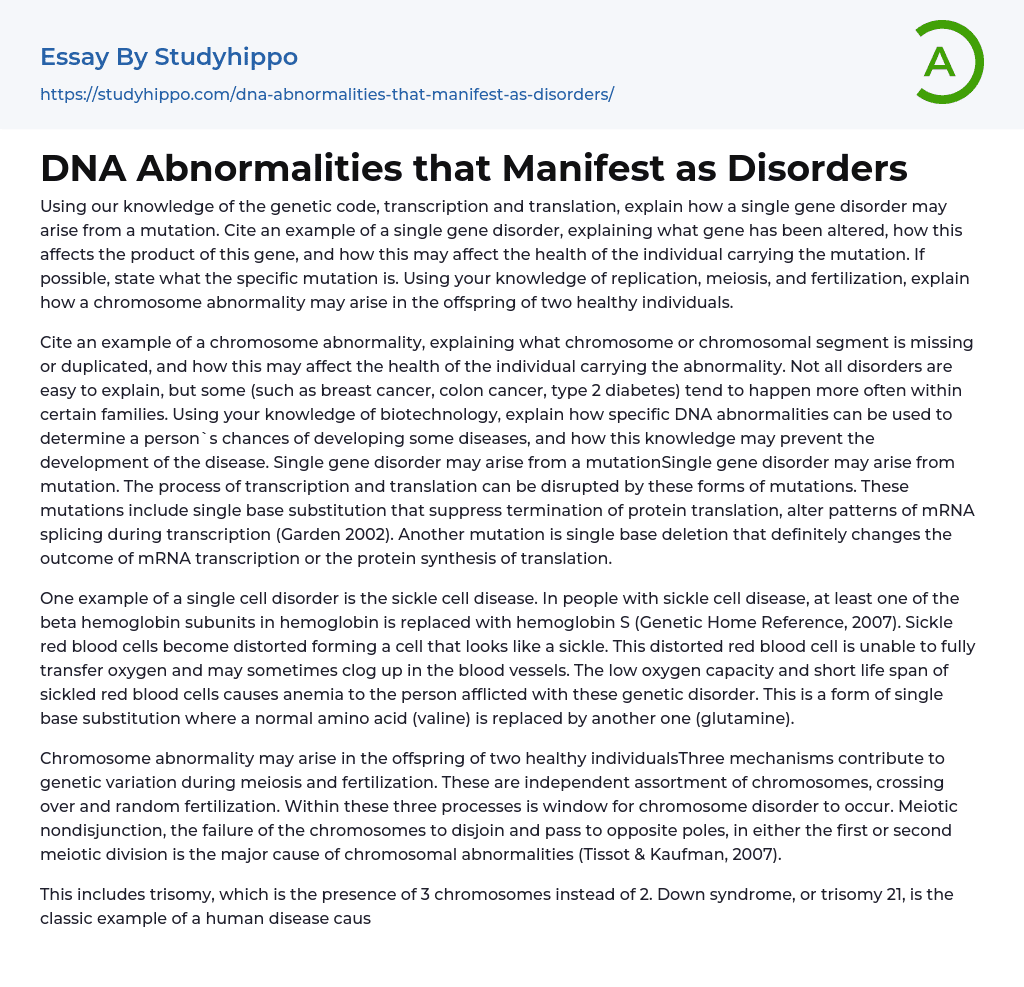By utilizing our knowledge of the genetic code, transcription, and translation, we can elucidate the mechanism through which a mutation can cause a single gene disorder. In this discussion, we will offer an illustration of such a disorder. This will encompass information concerning the gene that is affected, its influence on the final product generated, and any potential health ramifications for the afflicted individual. If accessible, specific details regarding the implicated mutation shall also be incorporated.
The text discusses the occurrence of chromosome abnormalities in offspring when two healthy individuals reproduce. It provides information on replication, meiosis, and fertilization. An example is used to illustrate a specific abnormality involving missing or duplicated chromosomes or segments, and it explains how this abnormality impacts the health of the individual carrying it. While some disorders lack clear explanations, certain conditi
...ons such as breast cancer, colon cancer, and type 2 diabetes tend to be hereditary. The text also explores how biotechnology can help identify DNA abnormalities that indicate an individual's susceptibility to certain diseases. Furthermore, it considers how this knowledge could potentially be utilized for preventing disease progression.
Single gene disorders can occur due to mutations, which disrupt the process of transcription and translation. These mutations can include single base substitutions that prevent termination of protein translation and alter mRNA splicing patterns during transcription (Garden 2002). Another type of mutation is single base deletion, which significantly affects mRNA transcription or protein synthesis. An example of a single gene disorder is sickle cell disease.
People with sickle cell disease have a genetic disorder where one of the beta hemoglobin subunits in their hemoglobin is replaced with hemoglobin S (Genetic Hom
Reference, 2007). This substitution causes their red blood cells to become distorted and take on a sickle-like shape. These distorted cells are unable to effectively carry oxygen and can sometimes block blood vessels. This genetic disorder leads to anemia due to the low oxygen capacity and short lifespan of the sickled red blood cells. The cause of this disorder is a single base substitution in which a normal amino acid, valine, is replaced by glutamine.
There are three mechanisms that contribute to genetic variation during meiosis and fertilization, which can lead to chromosome abnormality in the offspring of two healthy individuals. These mechanisms include independent assortment of chromosomes, crossing over, and random fertilization. Chromosome disorder can arise within these processes. One main cause of chromosomal abnormalities is meiotic nondisjunction, where chromosomes fail to separate and move to opposite poles during either the first or second meiotic division (Tissot & Kaufman, 2007). This failure can result in conditions such as trisomy, where there are three chromosomes instead of the usual two.
Down syndrome, also known as trisomy 21, is a well-known example of a human disease caused by autosomal nondisjunction. Some individuals affected by trisomy 21 survive (Tissot ; Kaufman, 2007). Trisomy 21 is characterized by the presence of an extra chromosome 21. Common characteristics of individuals with Down syndrome include oblique eye fissures with epicanthic skin folds at the inner corner of the eyes, poor muscle tone, a flat nasal bridge, a single palmar fold (also called a simian crease), a protruding tongue due to a small oral cavity and an enlarged tongue near the tonsils, a short neck, white spots on the iris called Brushfield spots,
excessive joint flexibility,
congenital heart defects, increased space between the first and second toe,
a single flexion furrow on the fifth finger,
and a higher number of ulnar loop dermatoglyphs (Wikipedia,
2007). Mental retardation commonly accompanies Down syndrome.
Certain DNA abnormalities can determine an individual's likelihood of developing specific diseases. While some minor DNA abnormalities may not cause immediate issues,
they can increase an individual's chances of developing certain diseases.
Comparing abnormal genes to normal genes allows scientists to identify slight differences in genes. Recent technological advancements, such as southern blotting and polymerase chain reaction, have made it possible to detect genetic disorders before they manifest as diseases. One example of this is the search for the gene responsible for hereditary nonpolyposis colorectal cancer (HNPCC), a significant form of colon cancer. Individuals inheriting the HNPCC gene face an 80% or higher risk of developing colon cancer and other cancers at an early age (Patlak, 2003). Furthermore, women with this gene are significantly more susceptible to uterine and ovarian cancer (Patlak, 2003). By applying the same principle, scientists can isolate specific genetic traits commonly observed among individuals affected by a particular disease.
The analysis of this gene's vulnerability to the disease provides an opportunity to forecast and avert its occurrence or develop a genetic remedy.
- Emergence essays
- Anxiety Disorder essays
- Post-traumatic Stress Disorder essays
- Addiction essays
- Anatomy and Physiology essays
- Biodegradation essays
- Cancer essays
- Dental Care essays
- Disability essays
- Disease essays
- Disorders essays
- Health Care essays
- Infectious Disease essays
- Inquiry essays
- Intelligence Quotient essays
- Lung Cancer essays
- Medicine essays
- Neurology essays
- Nutrition essays
- Olfaction essays
- Physical Exercise essays
- Public Health essays
- Sex essays
- Women's Health essays
- World health organization essays
- Dna essays
- Gene essays
- Mutation essays




